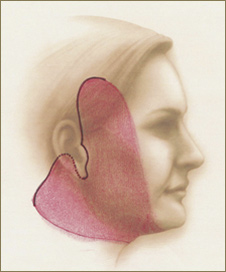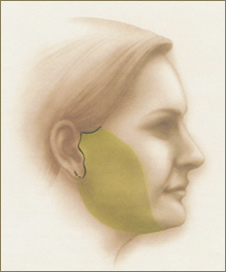
As our skin ages, it undergoes a process that reduces the number of collagen and elastic fibres and the skin’s ability to retain water, thus, at an individually variable rate, decreasing firmness, becoming more flabby, sagging, and deeper wrinkles appear. Sagging of the deeper layers of the subcutaneous tissue, mimic muscles, connective tissue plates, and facial fat pads due to decades of gravity also contributes to the aging of the face.
With facial plastic surgery, the age-related loosening and wrinkling of the facial skin can be reduced, and the sagging deeper layers can be lifted back into place, thus achieving a more youthful appearance by 10-15 years. In addition to traditional face-lifting surgeries, we have more and more procedures available to further improve our results. These include laser or chemical peeling, injection wrinkle filling, Botox treatment.
The classical face lifting surgery is performed with a long cut which starts at the forehead and runs in front of the ear, turns behind it and continues towards the nape. The skin of the cheeks and the upper neck is lifted to the smiling-wrinkle and after the lower tissue layers have been tightened, the skin is pulled upwards and backwards and of course the excess skin is removed. The fat layer of the submental area is removed by liposuction technique. Much of the resulting scar runs hidden in the area covered by hair, and around the ears it is so thin that it is hardly noticeable. The effects of the procedure are mainly on the sides of the face close to the smiling wrinkles and on the upper third of the neck, but it does not affect the area of the chin and lips. Here, wrinkle filling and laser peeling can be used as an additional method. The area of the temple is smoothed, but the wrinkles of the eyelids as well as the forehead may require separate surgery. The smiling-wrinkles cannot be made completely smooth, and the very deep wrinkles will remain. The effect of facelift is lasts for approx. 6-12 years but can be repeated a few times if needed.

Classical face lift

Short scar, mini face lift
Instead of classic facelift, we can perform a smaller, less extended procedure, called a mini facelift, in which a shorter scar runs in front of the ear during surgery. The effect of this intervention is mainly seen in the line of the chin and the upper part of the neck. This type of surgery also provides good results with less surgical effort, fewer complications, and shorter recovery times.
Mini facial surgeries are often performed around the age of 40, and classic surgeries are performed between the ages of 50 and 70. There is no upper age limit, but good general health is important. Certain diseases, especially not well-regulated blood pressure or diabetes, risk the success of surgery and can easily lead to complications. Smoking can be dangerous, depending on the daily amount smoked, surgery can only be performed if the patient refrains from smoking in the preceding weeks and months.
Surgery is usually performed under local anaesthesia, but general anaesthesia is also possible. Laboratory tests, / blood, urine / possibly ECG, are required before surgery. Surgery under local anaesthesia can be performed in an outpatient setting, i.e. after a few hours of rest you can go home. One night after general anaesthesia should be spent at the clinic.
After surgery, a thin drain (plastic tube) is placed on the wound area to drain out the wound exudate, which is removed within 24-48 hours. For two days after the procedure, a compression bandage is applied to the head, / like a helmet, only the face is left free / then a looser bandage is still needed for another week, but the entire head is still covered. In the first days, swelling of the face, minor discoloration and bleeding may occur near to the eyes. In the first weeks, the surgical area may be denser, harder to the touch, and minor irregularities may occur. From 7-8 days, no more bandaging is required, and the hair can be washed, but the last stitches are usually removed only on the 10-14th day. During this time, so approx. for 2 weeks, it is recommended to rest at home and to only come for a control examination and bandage change 2 or 3 times. It is advisable to sleep on a high pillow for 2-3 days after the operation, and especially to eat food that is easy to chew. During the first week, any activity that causes an increase in blood pressure, bending, lifting heavy objects, any sport or strenuous physical work is prohibited. It is also important to avoid any effect that may cause facial congestion or flushing: sunbathing, solarium, any strong warm effect, hot, highly spiced food, alcohol consumption. Hair coloring, make-up after the third week, sunbathing, solarium after 6-8 weeks is possible.
After facelift, more serious complications are rare, less severe problems can usually be treated with appropriate aftercare, and the outcome of the surgery is little or not affected. These may include bleeding in 4-5%. Transient skin sensory disturbances are rare and resolve within a few months. Skin necrosis is less than 1% and may occur in the area of skin behind the ear. Inflammation in facelift is rare due to the good blood supply of the area. Prolonged swelling and edema are rare. Dense thick scar formation or hair loss, hair thinning in the incision line can be solved with a little post-correction. Injuries to the facial nerve branches are very rare in 0.1%, with the unpleasant consequence of asymmetry in the function of the facial muscles.